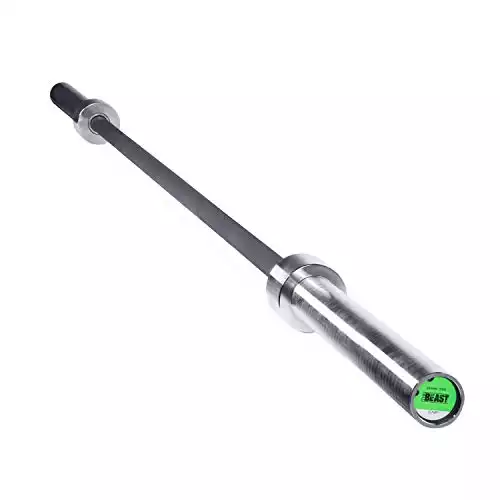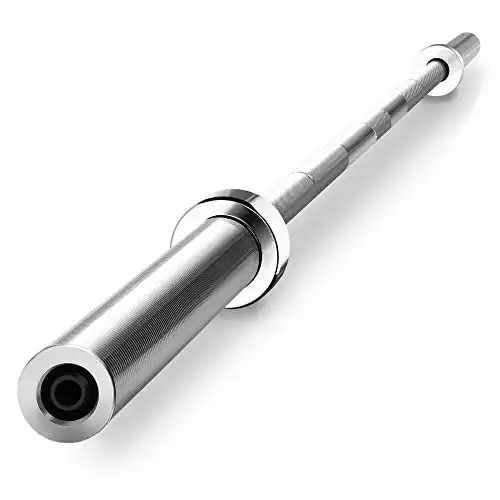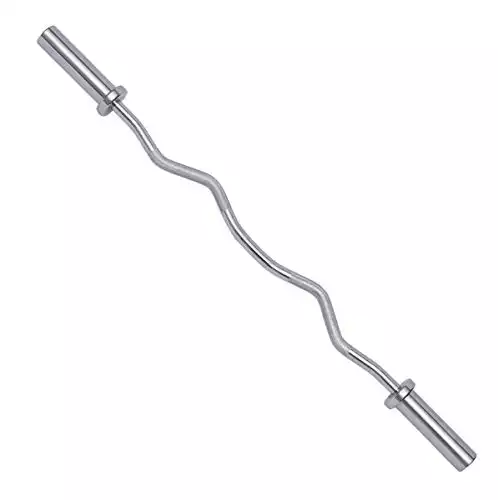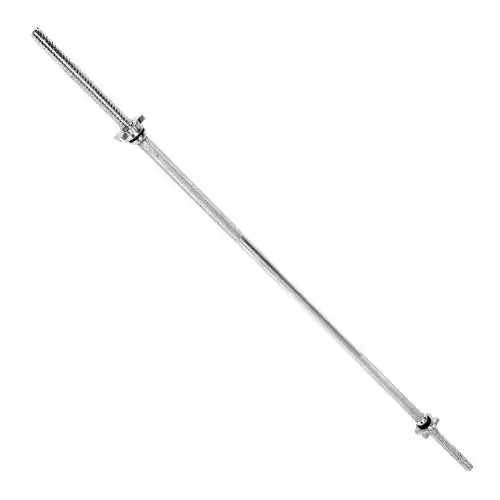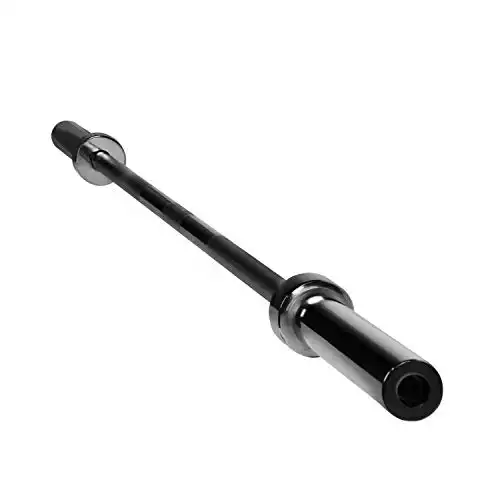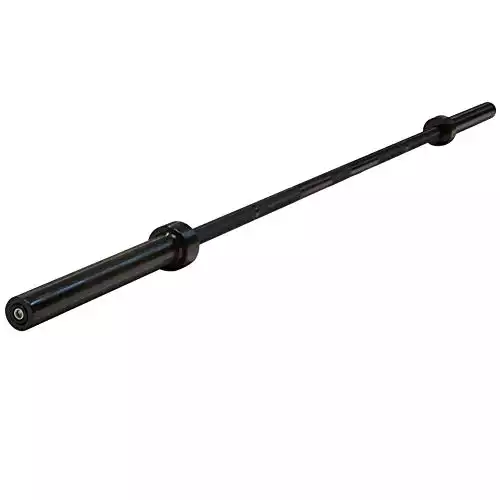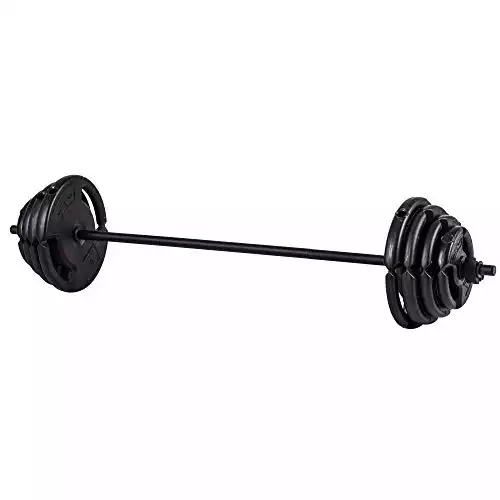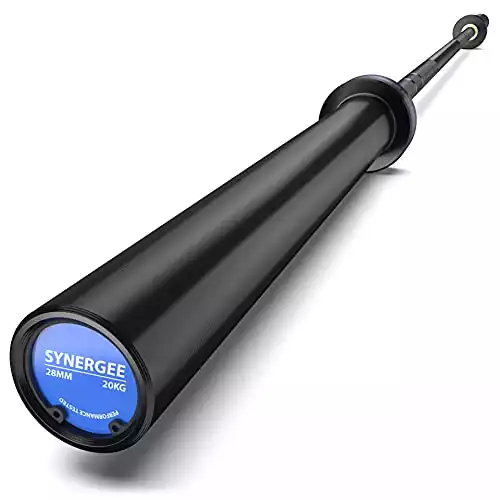Equipment
The 10 Best Barbells
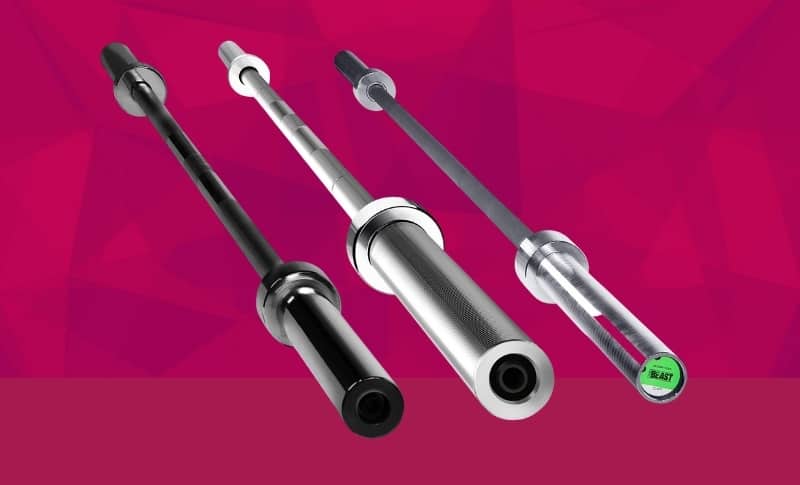
What are the best barbells on the market?
Barbells and dumbbells: the undisputed champions of resistance training, by sheer popularity.
Barbells, in particular, comprise the backbone behind entire sports: Olympic weightlifting, powerlifting, strongman, and CrossFit.
The prevalence of barbells and their level of integration in all-things-fitness might lead one to believe they’ve been around for centuries.
Surely, the concept of lifting a stick up and setting it down is nothing new.
Well, that’s partly true. People have been lifting for the purposes of physical development for thousands of years.
However, the barbells we know and use today were developed only around 200 years ago – in the early 1800s.
The barbell’s near-instantaneous rise to becoming one of the most fundamental pieces of strength-training equipment in human history is a testament to its efficacy and versatility.
A gym can hardly be considered complete without one.
So without further ado, here’s our roundup of the 10 best barbells you can buy for a range of different purposes.
The Best Barbells Compared
Our equipment lists are created by researching the best-reviewed products from the most reputable companies and web sources.
Here’s our list of the 10 best barbells:
In A Rush? Here’s Our Top Pick:
We’ve settled on CAP’s 7-foot Olympic bar for the number one spot on our list.
CAP is well-received in the home gym equipment space for supplying affordable options and a reliable level of quality in a market flooded with exorbitantly expensive or perpetually scarce gear.
A barbell can be broken down into 3 critical sections:
- The Bar – its length, diameter, and tensile strength (ability to endure bending forces)
- The Sleeves – the regions of the barbell where weight plates are loaded
- The Knurling – the rough, patterned lengths of metal along the bar’s length
CAP’s 20 KG, 7-foot barbell series is offered with a variety of tensile strength / PSI ratings from 110,000 to 230,000 PSI.
That’ll handle any amount of benching, squatting, or deadlifting you can throw their way.
The bar’s diameter sits at 28mm – a standard size commercially and in competitive strength sports.
CAP’s barbell is designed to rotate slightly about the sleeves. Olympic barbells do this to match the movement of the plates and lifter’s hands during certain movements – like a clean & jerk.
The knurling is gentle enough that beginners and intermediates won’t shred the skin on their hands but sharp enough to provide a boost to your grip security.
If you don’t spend another moment researching barbells after this sentence, you can grab one of CAP’s Olympic models with full confidence.
10. Yaheetech – Olympic 7-Foot Barbell
Starting off our list is a clean-cut, affordable bar that would make a fine choice for any beginner.
At 86” (7-ft), 39.5lbs base weight, and a 1.2in (30mm) grip diameter, Yaheetech’s Olympic 7-foot barbell meets all the requirements for a standard gym bar.
The knurling is medium depth, meaning it’ll stick to your palms securely without tearing them up too badly. At the entry-level, Yaheetech is a solid option.
Pros
- Beginner-friendly bar – secure yet light knurling that won’t rip up your hands
- Adequate sleeve sizing, space, and rotation to accommodate a full set of weight plates
- Gaps in knurling at the center and near the collars allow for various stances and grips
Cons
- 300lb weight limit design is on the low-end for barbell design – will start to deform if used near max weights frequently
- Reviews have noted susceptibility for corrosion depending on the environment
9. Nice C – Adjustable Barbell 2-in-1 Set
Nice C’s adjustable barbell set represents one of the more unique selections to be found here.
This piece of equipment is comprised of multiple components that can be combined into a barbell or separated into dumbbells.
Nice C includes a weight set designed specifically for the bar elements – up to 44 total lbs, including the bar(s).
You won’t be breaking any records with this 2-in-1 barbell set, but it can offer an impressive range of versatility for accessory/isolation movements.
A capable selection for small home gyms or travel-ready fitness collections.
Pros
- Performs the function of both a barbell and a set of dumbbells – great versatility for a home gym set-up with limited space
- Comes with a complimentary weight set – a 12 count in total (four 2.8lb plates, 3.3lb plates, 4.4lb plates each)
- Grooved, anti-slip neoprene grip which for added grip security – great for beginner, youth, or elderly trainees
Cons
- Not intended for heavy lifting – effectively limited to its accompanying weight set
- Completely non-standard length and width – not very transferable to traditional barbell training
8. Everyday Essentials – Olympic Barbell Curl Bar
Barbells come in a surprisingly varied spectrum of shapes, sizes, and curvatures. Curl bars are one of the most common secondary barbell designs.
Everyday Essentials is a well-known supplier of economical equipment with meritable quality.
Their curl bar is curved to complement a turned wrist angle during accessory movements, such as bicep curls and tricep extensions.
The angular helps to protect the elbows and wrists from excessive torsional strain during a lift.
Pros
- The curved design allows for optimal wrist position while executing accessory movements (bicep curls, tricep extensions)
- Well-placed knurling for grip width to help maximize range of motion and muscle recruitment
- 350lb weight limit provides more than enough legroom to perform accessory work, even at elite strength levels
Cons
- Not intended for heavier compound movements
- Reviews have noted some spec discrepancies – base weight seems to vary between 18 – 25lbs, and sleeve integrity can be inconsistent
7. CAP Barbell – 72-Inch Threaded Barbell
CAP’s 72-inch threaded barbell is yet another accessory-focused barbell variant.
It is specced to a thinner diameter and shorter (6-ft) length to provide better maneuverability in tighter spaces and superior grip to help you dominate your isolation exercises.
The bar is rated to 250lbs – giving you plenty of room to load your curls as heavy as you could want them.
Pros
- Great, sturdy 6-ft barbell variant for accessory movements and lighter compound exercises – 7-ft options can be more unwieldy
- 1in (~25mm) diameter allows for a full, powerful grip which improves leverage and engagement during bicep curls, tricep extensions, and forearm exercises
- 250lb weight limit is more than enough to hold all the weight you could need for isolation/accessory movements
Cons
- Not intended for heavyweight compound movements – this is an accessory bar first and foremost and will be much less durable than standard bars
- Intended to hold weight plates with 1-inch center holes – many types of plates will sit loosely on the bar
6. CAP Barbell – 6-Foot Olympic Barbell
CAP also offers a 6-foot barbell variant with a 28mm grip diameter. This makes it more comparable to 7-foot Olympic barbell measurements but in a slightly more compact package.
This is a bar well-suited to serving a small home/garage gym with space restrictions.
Pros
- 6-ft length and lighter base weight (28lbs) makes the bar superb for accessory/isolation exercises – more easily maneuvered than larger barbells
- Weight capacity of 500lbs allows lifters to perform compounds (squat, bench, deadlift) at respectable weights
Cons
- Relatively low tensile strength at 63,800 PSI – will begin to flex/deform well below its 500lb weight limit
- Rotating sleeves can be hit-or-miss for accessory movements – rotational instability can be detrimental to effective execution of tricep extensions or curls
5. Body-Solid – OB86B Olympic Barbell
Body-Solid’s OB86B Olympic barbell comes in at a 30mm grip diameter – a slice above the 25-28mm standard for similar bars.
The oxide finish layers over mid-depth knurling – in conjunction with the added grip width – make the bar a potent tool for grip training and forearm development.
Pros
- 30mm bar diameter is 2-3mm above most standard barbell specifications – a subtle difference that can provide significant benefits to grip training and strength over time
- Black/chrome oxide finish to protect against surface damage to the bar
Cons
- 600lb weight limit may be too restrictive for athletes serious about pushing heavier weights – deformation can occur at 200-300lbs
- Bolt-on collar at the sleeves have a tendency to loosen over time
4. Step Fitness – Club Quality 4-Weight Deluxe Barbell Set
Another multi-piece unit, Step Fitness’ 4-weight barbell set, offers a simple yet effective option for individuals hoping to gear out a gym in the garage, office, or car trunk.
The set comes with 60lbs of total weight – bar pieces included. Each component is ergonomically designed for easy movement, adjustment, and loading/unloading.
Pros
- Multi-component, 1” diameter steel bar designed with accessory and isolation movements in mind – includes its own weight set (two 2.75lb plates, 5.5lb plates, 8.25lb plates, 11lb plates)
- Intuitively grooved bar and weight plate set to guarantee secure grip and maneuverability
Cons
- Total weight set with the bar included only amounts to 60lbs – adequate for beginner-level accessory movements, but not much else, and many will quickly outpace the equipment
- Bar arrives in separate parts – but can feel a bit wobbly even after being put together
3. Synergee – Regional Olympic Barbell
Synergee’s Regional Olympic Barbell might just be the strongest bar on our list.
Rated to 1500lbs and with a 190,000 PSI tensile strength, this bar was crafted to meet the need of serious, heavy-duty lifters.
The high tensile strength and above-average bar thickness (30mm) make the Regional Olympic perfect for powerlifting movements like the squat, bench press, and deadlift.
Unlike many competing suppliers, Synergee also offers an any-reason return/replacement policy on their equipment.
When you’re investing hundreds of dollars, that kind of assurance is a significant bonus.
Pros
- 1,500lb weight capacity and 190,000 PSI tensile strength rating – superior durability and resilience that suits experienced lifters capable of high-intensity lifting (lifts in excess of 400lbs)
- Construction specially tailored to balance stiffness and balance – accommodates dynamic power movements (e.g., cleans) and more stable compounds (e.g., squats)
- Synergee offers an any-reason replacement policy on their barbell
Cons
- Reviews have experienced some inconsistencies in collar rotation – sometimes too restrictive, sometimes too loose
2. Sporzon! – Olympic Weightlifting Barbell
A funny thing about quality Olympic lifting equipment: the more simple they appear, the better suited they tend to be.
Sporzon’s Olympic weightlifting barbell is about a straightforward as a bar can be.
The bar is offered in multiple sizes between 1- and 2-inch diameters, 5-foot, 6-foot, 7-foot lengths, and up to a 700lb weight capacity.
Pros
- Multiple length and diameter options (1-in, 2-in, 5-ft, 6-ft, 7-ft) to meet varying needs – compounds and accessories
- 700lb weight rating indicates a solid base for beginner and intermediate lifters performing heavier compounds
Cons
- Reviews sometimes note the base weight of the bar is inaccurate – weighing as little as 33lbs rather than the stated 45lbs
- Ridged sleeves can make it difficult to load certain plate designs onto the bar
1. CAP – Barbell 7-Foot Olympic Bar
Our number one pick is offered in strength ratings from 110,000 PSI to 230,000 PSI.
This makes it an impressive choice for nearly anyone – those looking for a quick, easy, and economical option for their personal gym, or seasoned lifters looking for a quality barbell capable of being loaded over 400lbs.
Somewhat uniquely, this model lacks center knurling.
While a drawback for back squat stability, removing the center knurling protects the shins during conventional deadlifts and the collar/neck during front-loaded lifts (front squats, cleans, etc.)
Pros
- Widest range of tensile strength options on our list – from 110,000 PSI (beginner level equipment) to 230,000 PSI (adept level equipment)
- Medium depth knurling for a smooth balance between grip security and minimized skin abrasion
- No center knurling allows the bar to sit more comfortably in front rack positions (e.g., front squats, cleans, overhead press)
Cons
- No center knurling makes the bar less than ideal for back squats
FAQs About Barbells
Here are our answers to some of the most frequently asked questions about barbells:
Q: What is the purpose of barbells?
A better question might be, “What is a barbell not purposed for?”
On some level, barbells are an inseparable facet of strength training.
There are virtually no athletic movements (strength-, power-, endurance-based) that cannot be adapted into an effective barbell-specific form.
Squats, deadlifts, presses, cleans, jerks, snatches, rows, lunges, good mornings, jumps, swings, rollers – it would take an encyclopedia to fully document the range of applications offered by a single barbell.
Why shouldn’t it? Think about what a barbell really is. Literally speaking, it’s a stick with the capacity for bearing significant amounts of weight.
Nothing exemplifies the primordial notion of picking something up (and then setting it down) better than a barbell.
Purpose is a rather fluid word. Your purpose could simply be to deadlift 700lbs at some point in your life – in which case; a barbell would be absolutely necessary.
Perhaps you want to add a few inches to your vertical jump. Barbell movements can be programmed to help you achieve that.
With intelligent use, barbells can be aligned to nearly any fitness objective.
There will always be a debate surrounding the effectiveness of barbell training versus alternatives, like dumbbells, kettlebells, or calisthenics.
Q: What kind of barbell is best?
The best barbell is the one that best suits your specific training goals.
Some considerations:
- Grip knurling – sharpness, density, location on the bar.
- Bar slack – how much the bar flexes/bends under load. This significantly impacts heavier deadlifts and Olympic weightlifting movements. Bar bend shouldn’t necessarily be associated with the tensile / yield strength of the material. Case in point: deadlift bars are distinctly engineered to provide greater whip, but tend to have enormous tensile and yield strengths.
- Sleeve length and rotation – where the weight plates are loaded. The length of the sleeve can affect how many plates you’re able to load. The capacity for rotation at the sleeves’ collars will change how the weight feels during dynamic movements. For example, if the bar cannot rotate smoothly during an explosive clean, it may roll in the lifter’s hand or be forced out of position.
Q: What size barbell should I get?
For general fitness development, the subtle design elements of a barbell aren’t going to drastically alter the efficiency of your training.
The more specific your goals get, the more you’ll get out of special characteristics like knurling, bar whip, length, and/or thickness.
Big on grip training? A thicker bar with lighter knurling will demand much more out of your forearms than thinner, grippier alternatives.
Are you a larger person? Long arms or legs? Definitely consider longer barbells that can accommodate your natural grip and stance spacing.
A wide grip bench press for someone else might be a close grip for you – and your barbell should reflect that.
Training with equipment that is consistent with your body’s unique sets of leverage makes a world of difference in sustaining healthy, smooth progress in the gym.
Q: Is a 7ft barbell too long?
Absolutely not. One of the most revered design standards in strength sports – the Olympic barbell – is specced to 7.2-ft.
In fact, the majority of weightlifting, powerlifting, and cross-training federations use 7-ft barbells as their baseline.
Barbells get longer than that, too. Bars specifically designed for deadlifting are rolled to ranges between 7.5 – 8 feet.
Strongmen might be familiar with the lesser-known “elephant bar,” which stands at 9 feet.
Q: Can you bench press with a 5 ft bar?
Here’s a little-known secret: you can perform a bench press with just about anything. A bar of any kind? That’s just a level of optimization.
However, if you’re working on building an effective home gym, or are simply collecting pieces for personal use, the compatibility of your equipment might come with a few caveats.
Most standard power and bench racks are built to a 48” width. These are the kinds of racks you’ll find in commercial gyms around the globe.
A 5-ft bar translates to 60” – meaning it wouldn’t fit well on an ordinary rack without contacting the bar’s sleeves.
That leaves lifting the bar yourself and floor pressing – both of which are viable strength-building movements, but extremely dangerous to perform without an appropriate rack.
Another important consideration here is your bench press grip width. Anyone with a wingspan over 6-ft might have trouble finding a comfortable natural width to grip the bar with.
There’s nothing objectively wrong with exclusively close grip benching, but you’ll certainly be more limited in your programming.
Q: Can you squat with a 5 foot bar?
5-ft barbells also tend to run light (~30-35lbs) and are incapable of bearing as much weight as larger options.
Generally, they’re intended for lighter, isolation exercises and home gyms with strict space limitations.
Q: Can you deadlift with a 6ft bar?
To build a heavier deadlift, longer is nearly always better.
More length intuits a greater degree of flex, resulting in a reduced range of motion from the floor and improved biomechanical leverage.
For these reasons, deadlift bars are regularly built to 7.5-ft – 9-ft in length.
Q: What is the best barbell for bench press?
7-ft is the standard-issue length for barbells in strength sports and most general fitness endeavors.
At this length, you’ll have the flexibility to experiment with a wide variety of grip widths, stances, and bar paths that can be difficult to emulate with shorter bars.
Building strength in a compound movement like the bench press relies squarely on smart training principles.
No one truly wants, needs, or should have to re-invent the wheel when it comes to progressing in the gym.
Bench press technique and programming have been studied and applied by millions of lifters and athletes.
The vast majority of these efforts were conducted with similar equipment, in similar conditions – starting with a 7-ft Olympic-grade barbell.
Q: What size barbell should a woman use?
Let’s be honest: the rationale for a “woman’s barbell” is rooted in a multitude of archaic notions regarding women’s physical stature.
Barbells marketed to women are crafted to be lighter and thinner – appealing to the stereotypical notion that women have smaller hands and bodies than men.
There’s no question that men tend to out-size their counterparts, but that hardly necessitates an entirely separate classification of lifting equipment.
Gender specifications in barbell design are little more than a relic of former eras. There’s no inherent reason that a woman should need to use a barbell of different dimensions than a man.
Women strength athletes can be found regularly squatting and deadlifting 500-600lbs. Strength like that doesn’t require any kind of special treatment or qualifier – it’s just flat-out strong.
Still, there are some modern implementations of women’s bars in high-level competition. The IWF and Olympics use a women’s bar for their female weightlifting events.
These bars are 25mm in diameter, compared to the 28mm bar male competitors use.
Women’s weight classes go as low as 49kg (108lbs), and we can imagine hand size plays a bigger role in such categories.
Your potential is your own. Your training needs are your own. Use whatever bar size you need to accomplish your goals, regardless of gender.
Q: What are the health risks of lifting a barbell?
There are no innate health risks to lifting with a barbell beyond the general concerns that come with any form of resistance training.
Resistance training has its share of horror stories – and they come in all shapes and sizes. However, that’s the case for any physically taxing endeavor.
Swimming, running, biking, climbing, gymnastics – name the activity, and you are sure to find countless individuals who have been injured.
Mechanically speaking, barbell training can often be much safer than fitness alternatives. There are simply fewer vectors for danger in the execution of barbell-oriented movements.
A gymnast contends with incredibly difficult positions, manipulating their bodies in ways that demand high levels of flexibility and mobility.
Comparatively, a barbell can really only ever be moved in a straight (or slightly curved) line.
The majority of barbell-based movements are merely weighted variations of natural motions we already perform dozens (if not hundreds) of times a day – squatting, pressing, deadlifting, and so forth.
Proper physical preparedness and technique theoretically drops the risk of injury to the floor.
Of course, risks can only ever be mitigated – never fully eliminated. It is possible to suffer muscle strains, hernias, abrasions, or bruising from barbell training.
Such risks put an exclamation point on the importance of form, proper programming, recovery, hydration, and holistic health.
Q: Are Olympic barbells better than alternatives?
“Better” is an ambiguous term in the world of fitness equipment.
Typically, Olympic barbells are made with a certain level of quality that is hugely beneficial to an athlete.
There’s nothing worse than equipment that feels unbalanced, uneven, too smooth or too rough, unstable, or of shoddy make.
Q: Are cheap barbells worth it?
True fitness is a way of life, and a game of longevity. As a pillar of fitness, strength training should be approached as a long-term habit.
Patience, consistency, and discipline will take you much further than “get jacked quick” schemes, or gimmicky equipment.
Your equipment selections should complement that sense of consistency in your training.
If you expect your body to hold up over the years, you should expect the same out of your barbell.
Doing so will reduce the risk of subtle changes in your lifting, like the bar warping and causing one side to feel heavier than the other. A deformed bar is a dangerous bar.
Q: How long does a barbell last?
Proper maintenance and appropriate use of a quality barbell can keep the train going for decades, if not indefinitely.
This is another reason to consider putting more money into your investment. A good bar can last a lifetime.
How a bar holds up aesthetically over time can be a different story that depends on the bar’s coating, metal composition, and its primary use.
It’s not uncommon for a barbell to wear the scars of its years proudly.
The grip knurling might begin to dull or soften after several years of high-frequency use, or a collar might loosen from repeatedly smashing against the floor.
Many times, these issues can be covered under a manufacturer’s warranty policy.
Regardless, a high-quality barbell will be one of the most reliable and resilient pieces of training equipment you can own.
Q: Can barbells snap?
Technically, yes – barbells do have a point at which they’ll snap.
The way barbells are designed makes it incredibly unlikely that a snap will occur suddenly or surprisingly.
Unless there is a serious flaw in the welding and/or rolling of the barbell, a snap could only ever occur after an extreme amount of flex has been put into the bar.
There are numerous videos showcasing world-class athletes lifting weights well beyond the tensile strength of a given barbell – only to have it nearly fold around their back during a squat, or fail to leave the ground in a deadlift because the bar continues to bend.
While comical, these clips showcase the nature of barbell design. Flexibility is always prioritized over stiffness, even in bars that are intentionally built to be more rigid.
Barbells are also graded for their tensile and yield strength during manufacturing. The general range for tensile strength in an average barbell falls between 100,000 – 230,000 PSI.
Commercial barbells ordinarily rank in the 170,000 – 190,000 PSI range. A higher tensile strength rating means the barbell can bear more load before deforming.
A lower rating indicates that the bar will begin to bend at lighter weights.
Manufacturers sometimes add a “pound rating” to their barbells. According to this system, a 1000lb rated barbell is suited to handling up to half a ton in weight.
However, this can be a little misleading, as it does not depend upon the bar’s structural integrity or resilience to warping at max load ranges.
Sticking to yield strength tends to be a superior indicator of barbell quality.
Q: At what weight does a barbell bend?
Barbells start bending once any weight is applied to their sleeves. The degree to which the bar bends will depend entirely on how much weight you add.
Commercial barbells usually start showing visible deformation at around 275 – 315lbs. Competition grade barbells might not seem to flex at all until over 400 (or even 500) pounds.
Longer barbells, such as deadlift bars, are intended to flex much more than standard Olympic variants.
A lifter might experience the sensation of a whip on the bar at 200lbs, with a couple of inches of bend by the time 500lbs or more have been added.
Q: How much does a 6ft Olympic bar weigh?
6-ft long barbells most often weigh between 25 and 35lbs.
Q: Can I use an Olympic bar on a standard bench?
Of course. Standard Olympic bars largely make up the baseline design for barbells used in commercial and private gym settings all across the world.
Q: How do I choose a barbell? Which should I choose?
As mentioned above, a good barbell will last you for the entirety of your training lifetime – assuming proper care and maintenance.
Quality construction should be your first point of attention.
Next? Goals, goals, goals. Are you looking to compete, maximize your deadlift, or focus on bodybuilding isolation movements?
The answer to these questions can help guide you to the appropriate barbell for your training purposes.
Summary
The barbell is a timeless tool that has been integrated into every microcosm of fitness at some point throughout history.
There’s nothing more straightforward than picking up a bar and setting it down.
Our top 10 list showcases some of the diversity offered by barbells – from competition grade 7-ft options, to curl bars, to more niche adjustable patents.
Their variability reflects the creative core that drives physical development.
Think of a barbell as a sculpting tool you can use to treat the marble of your body – aesthetically, performance-wise, or cardiovascularly.
We’ve covered some of the best and most affordable options on the market to get you started. The rest is up to you.
Here’s a quick recap of the 10 best barbells:
- CAP – Barbell 7-Foot Olympic Bar (Best Barbell Overall)
- Sporzon! – Olympic Weightlifting Barbell (Best Olympic Barbell)
- Synergee – Regional Olympic Barbell (Best Barbell For Powerlifting)
- Step Fitness – Club Quality 4-Weight Deluxe Barbell Set (Best All-In-One Barbell)
- Body-Solid – OB86B Olympic Barbell (Best Barbell For Grip)
- CAP Barbell – 6-Foot Olympic Barbell (Best 6-Foot Barbell)
- CAP Barbell – 72-Inch Threaded Barbell (Best Lightweight Barbell)
- Everyday Essentials – Olympic Barbell Curl Bar (Best Accessory Barbell)
- Nice C – Adjustable Barbell 2-in-1 Set (Best Barbell For Travel)
- Yaheetech – Olympic 7-Foot Barbell (Best Barbell For Beginners)

